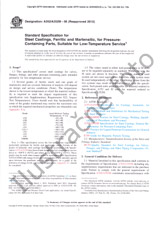Potrebujeme váš súhlas na využitie jednotlivých dát, aby sa vám okrem iného mohli ukazovať informácie týkajúce sa vašich záujmov. Súhlas udelíte kliknutím na tlačidlo „OK“.
ASTM E399-22
Standard Test Method for Linear-Elastic Plane-Strain Fracture Toughness of Metallic Materials
NORMA vydaná dňa 1.6.2022
Informácie o norme:
Označenie normy: ASTM E399-22
Poznámka: NEPLATNÁ
Dátum vydania normy: 1.6.2022
Kód tovaru: NS-1067015
Počet strán: 39
Približná hmotnosť: 117 g (0.26 libier)
Krajina: Americká technická norma
Kategória: Technické normy ASTM
Kategórie - podobné normy:
Anotácia textu normy ASTM E399-22 :
Keywords:
ICS Number Code 77.040.10 (Mechanical testing of metals)
Doplňujúce informácie
| Significance and Use | ||||||||||||||||||||||||||||||||||||||||||||||||||||||||||||||||||||||||||||||||||||||||||||||||||||
|
5.1?The property 5.1.1?Variation in the value of KIc can be expected within the allowable range of specimen proportions, a/W and W/B. KIc may also be expected to rise with increasing ligament size. Notwithstanding these variations, however, KIc is believed to represent a lower limiting value of fracture toughness (for 2 % apparent crack extension) in the environment and at the speed and temperature of the test. 5.1.2?Lower values of KIc can be obtained for materials that fail by cleavage fracture; for example, ferritic steels in the ductile-to-brittle transition region or below, where the crack front length affects the measurement in a stochastic manner independent of crack front constraint. The present test method does not apply to such materials and the user is referred to Test Method E1921 and E1820. Likewise this test method does not apply to high toughness or high tearing-resistance materials whose failure is accompanied by appreciable amounts of plasticity. Guidance on testing elastic-plastic materials is given in Test Method E1820. 5.1.3?The value of KIc obtained by this test method may be used to estimate the relation between failure stress and crack size for a material in service wherein the conditions of high constraint described above would be expected. Background information concerning the basis for development of this test method in terms of linear elastic fracture mechanics may be found in Refs 5.1.4?Cyclic forces can cause crack extension at 5.1.5?Plane-strain fracture toughness testing is unusual in that there can be no advance assurance that a valid 5.1.6 Residual stresses can introduce bias into the indicated 5.2?This test method can serve the following purposes: 5.2.1?In research and development, to establish in quantitative terms significant to service performance, the effects of metallurgical variables such as composition or heat treatment, or of fabricating operations such as welding or forming, on the fracture toughness of new or existing materials. 5.2.2?In service evaluation, to establish the suitability of a material for a specific application for which the stress conditions are prescribed and for which maximum flaw sizes can be established with confidence. FIG.
2 DoubleCantilever Clip-In Displacement Gage Showing
Mounting by Means of Integral Knife Edges 5.2.3?For specifications of acceptance and manufacturing quality control, but only when there is a sound basis for specifying minimum KIc values, and then only if the dimensions of the product are sufficient to provide specimens of the size required for valid KIc determination. The specification of KIc values in relation to a particular application should signify that a fracture control study has been conducted for the component in relation to the expected loading and environment, and in relation to the sensitivity and reliability of the crack detection procedures that are to be applied prior to service and subsequently during the anticipated life. |
||||||||||||||||||||||||||||||||||||||||||||||||||||||||||||||||||||||||||||||||||||||||||||||||||||
| 1. Scope | ||||||||||||||||||||||||||||||||||||||||||||||||||||||||||||||||||||||||||||||||||||||||||||||||||||
|
1.1?This test method covers the determination of fracture toughness (1.1.1?The KIc test procedure is described in the main body of this test standard and is a mandatory part of the testing and results reporting procedure for this test method. The 1.1.2?The KIsi test procedure is described in Appendix X1 and is an optional part of this test method. The KIsi test procedure is based on a fixed amount of crack extension of 0.5 mm, and as a result, Note 1:?Plane-strain fracture toughness tests of materials thinner than 1.6 mm (0.063 in.) that are sufficiently brittle (see 7.1) can be made using other types of specimens 1.2?This test method is divided into two parts. The first part gives general recommendations and requirements for testing and includes specific requirements for the KIc test procedure. The second part consists of Annexes that give specific information on displacement gage and loading fixture design, special requirements for individual specimen configurations, and detailed procedures for fatigue precracking. Additional annexes are provided that give specific procedures for beryllium and rapid-force testing, and the 1.3?General information and requirements common to all specimen configurations:
1.4?Specific requirements related to test apparatus:
1.5?Specific requirements related to individual specimen configurations:
1.6?Specific requirements related to special test procedures:
1.7?The values stated in SI units are to be regarded as the standard. The values given in parentheses are for information only. 1.8?This standard does not purport to address all of the safety concerns, if any, associated with its use. It is the responsibility of the user of this standard to establish appropriate safety, health, and environmental practices and determine the applicability of regulatory limitations prior to use. 1.9?This international standard was developed in accordance with internationally recognized principles on standardization established in the Decision on Principles for the Development of International Standards, Guides and Recommendations issued by the World Trade Organization Technical Barriers to Trade (TBT) Committee. |
||||||||||||||||||||||||||||||||||||||||||||||||||||||||||||||||||||||||||||||||||||||||||||||||||||
| 2. Referenced Documents | ||||||||||||||||||||||||||||||||||||||||||||||||||||||||||||||||||||||||||||||||||||||||||||||||||||
|




 Cookies
Cookies
